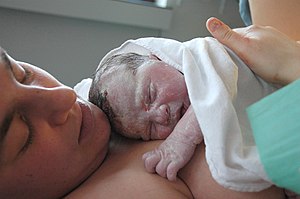Maternity ward
| Childbirth | |
|---|---|
| Synonyms | partus, parturition, birth |
 |
|
| Newborn infant and mother | |
| Classification and external resources | |
| Specialty | Obstetrics, midwifery |
Childbirth, also known as labour and delivery, is the ending of a pregnancy by one or more babies leaving a woman's uterus. In 2015 there were about 135 million births globally. About 15 million were born before 37 weeks of gestation, while between 3 and 12% were born after 42 weeks. In the developed world most deliveries occur in hospital, while in the developing world most births take place at home with the support of a traditional birth attendant.
The most common way of childbirth is a vaginal delivery. It involves three stages of labour: the shortening and opening of the cervix, descent and birth of the baby, and the pushing out of the placenta. The first stage typically lasts twelve to nineteen hours, the second stage twenty minutes to two hours, and the third stage five to thirty minutes. The first stage begins with crampy abdominal or back pains that last around half a minute and occur every ten to thirty minutes. The crampy pains become stronger and closer together over time. During the second stage pushing with contractions may occur. In the third stage delayed clamping of the umbilical cord is generally recommended. A number of methods can help with pain such as relaxation techniques, opioids, and spinal blocks.
Most babies are born head first; however about 4% are born feet or first, known as breech. During labour a woman can generally eat and move around as she likes, but pushing is not recommended during the first stage or during delivery of the head, and enemas are not recommended. While making a cut to the opening of the vagina is common, known as an episiotomy, it is generally not needed. In 2012, about 23 million deliveries occurred by a surgical procedure known as Caesarean section. Caesarean sections may be recommended for twins, signs of distress in the baby, or breech position. This method of delivery can take longer to heal from.
...
Wikipedia
